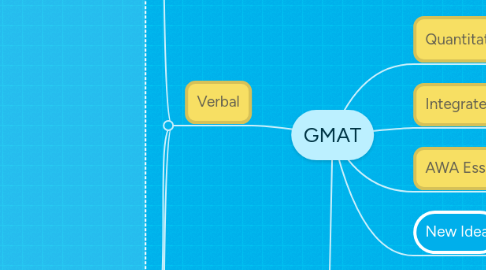
1. Quantitative
1.1. CAT I
1.1.1. Combinatorics
1.1.1.1. Remember All Factorials from 1! - 6!
1.1.1.2. Count Possibility (making decisions)
1.1.1.3. Arranging Different Groups (Unique)
1.1.1.4. Arranging Different Groups (Repetition Allowed)
1.1.1.5. Multiple Groups (Add and Multiple at once)
1.1.1.6. Problem Sets
1.1.2. Overlapping Sets
1.1.2.1. The Double-Set Matrix
1.1.2.2. Percents
1.1.2.3. Algebraic Representation
1.1.2.4. 2 Sets, 3 Choices: Still Double-Set Matrix
1.1.2.5. 3-Set Problems: Venn Diagrams
1.1.2.6. Problem Sets
1.1.3. Divisibility & Primes
1.1.3.1. Rules of Divisibility by Integers
1.1.3.2. Divisibility and Addition/Subtraction
1.1.3.3. Prime Numbers (Memorize)
1.1.3.4. Prime Factorization
1.1.3.5. Prime Box
1.1.3.6. GCF & LCM - Greatest Common Factor & Least Common Multiple
1.1.3.6.1. Finding GCF and LCM Using Venn Diagrams
1.1.3.7. Remainders
1.1.3.7.1. Decimal Reminders (Page 24)
1.1.4. Lines & Angles
1.1.4.1. General Rules
1.1.4.2. Intersecting Lines
1.1.4.3. Exterior Angle of a Triangle
1.1.4.4. Parallel Lines Cut by a Transversal
1.2. CAT II
1.2.1. Consecutive Integers
1.2.1.1. Counting Integers
1.2.1.2. Integer Properties
1.2.1.2.1. Consecutive Multiples
1.2.1.2.2. Evenly Spaced Sets
1.2.1.2.3. Consecutive Integers
1.2.1.3. Sum of Consecutive Integers
1.2.2. Digits & Decimals
1.2.2.1. Place Value
1.2.2.2. Shifting the Decimal
1.2.2.3. Decimal Operations
1.2.2.4. Powers and Roots
1.2.3. Percents
1.2.3.1. Percentage Increase/Decrease
1.2.3.2. Successive Percents
1.2.3.3. Compound Interest
1.2.4. Statistics
1.2.4.1. Average
1.2.4.2. Weighted Average
1.2.4.3. Median
1.2.4.4. Standard Deviation
1.3. CAT III
1.3.1. Algebraic Translations
1.3.1.1. Common Relationships
1.3.1.2. Integer Constraints
1.3.1.3. Awesome Unit Conversion Tactic
1.3.2. Coordinate Plane
1.3.2.1. Properties of Lines
1.3.2.2. Positive and Negative Quadrants
1.3.3. Fractions
1.3.3.1. Simplification Techniques
1.3.3.1.1. Multiplication Shortcut
1.3.3.1.2. No Shortcuts for Addition or Subtraction
1.3.3.1.3. Dividing Fractions: Use the Reciprocal
1.3.3.1.4. Comparing Fractions: Cross Multiply!
1.3.3.2. Never Split the Demoninator
1.3.4. Polygons
1.3.4.1. Overview
1.3.4.2. Interior Angles of Polygons
1.3.4.3. Area
1.3.4.4. Surface Area
1.3.4.5. Volume
1.3.5. Rates & Work
1.3.6. Ratios
1.3.6.1. Setting up Ratios
1.3.6.2. The Unknown Multiplier
1.3.6.3. Multiple Ratios: Make a Common Term
1.3.7. Triangles & Diagonals
1.3.7.1. Triangle Properties
1.3.7.2. Common Right Triangles
1.3.7.3. Diagonals of Other Polygons
1.3.7.4. Similar Triangles
1.3.7.5. Area of a Triangle (1/2bh)
1.4. CAT IV
1.4.1. Exponents & Roots
1.4.2. Extra Problem Types
1.4.3. FDPs
1.4.4. Inequalities
1.4.4.1. Manipulating Compound Inequalities
1.4.4.2. Consider Positive, Negative, Decimals, and Zero
1.4.4.3. Inequalities and Absolute Value
1.4.4.4. Square-Rooting Inequalities
1.4.5. Odds & Evens
1.4.6. Probability
1.4.6.1. Complementary
1.4.6.2. Mutually Exclusive Events
1.4.6.3. Probability of Event A OR Event B
1.4.7. Quadratic Equations
1.4.7.1. Factoring
1.4.7.2. Perfect Square Equations
1.4.7.3. Quadratic Formula (What to Know)
1.5. CAT V
1.5.1. Circles & Cylinders
1.5.1.1. Radium, Diameter, Circumference, and Area
1.5.1.2. Arc Length, Perimeter of a Sector
1.5.1.3. Inscribed vs. Central Angles
1.5.1.4. Inscribed Triangles
1.5.1.5. Cylinders and Volume
1.5.1.6. Surface Area of a Cylinder
1.5.2. Formulas
1.5.2.1. Plug-In Formulas
1.5.2.2. Strange Symbol Formulas
1.5.2.3. Formulas with Unspecified Amounts
1.5.2.4. Sequence Formulas
1.5.2.5. Recursive Sequences
1.5.2.6. Sequences and Patterns
1.5.3. Linear Equations
1.5.4. Positives & Negatives
2. Verbal
2.1. Critical Reasoning
2.1.1. CAT I
2.1.1.1. Resolve a Problem
2.1.2. CAT II
2.1.2.1. Inference
2.1.2.1.1. Conclusion must be Guaranteed
2.1.3. CAT III
2.1.3.1. Describe the Role
2.1.3.2. Complete the Argument
2.1.4. CAT IV
2.1.4.1. Provide an Example
2.1.5. CAT V
2.1.5.1. Evaluate the Conclusion
2.1.5.2. Find the Assumption
2.1.5.2.1. Strategy
2.1.5.2.2. Negation Technique
2.1.5.3. Strengthen the Argument
2.1.5.4. Weaken the Argument
2.1.5.5. Explain the Discrepancy
2.1.5.6. Evaluate the Argument
2.1.5.7. Flaw
2.2. Sentence Correction
2.2.1. CAT III
2.2.1.1. Connecting Punctuation
2.2.1.2. Verb Tense
2.2.1.2.1. Simple Tense
2.2.1.2.2. Progressive Tense
2.2.1.2.3. Perfect Tense
2.2.1.3. Word Choices
2.2.1.3.1. lay vs. lie
2.2.1.3.2. between vs. among
2.2.1.3.3. comparatives vs. superlatives
2.2.1.3.4. if vs. whether
2.2.1.3.5. Countable vs. Uncountable Items
2.2.1.3.6. rather than vs. instead of
2.2.1.3.7. affect vs. effect
2.2.1.4. Passive vs. Active Sentences
2.2.2. CAT IV
2.2.2.1. Comparisons
2.2.2.2. Subject-Verb Agreement
2.2.2.3. Pronouns
2.2.2.3.1. Personal Pronouns
2.2.2.3.2. Demonstrative Pronouns
2.2.2.3.3. Indefinite Pronouns
2.2.2.3.4. Exception to the rule
2.2.2.4. Modifiers
2.2.2.4.1. Noun Modifiers
2.2.2.4.2. Verb Modifiers
2.2.2.4.3. Relative Clauses
2.2.2.5. Idioms
2.2.2.6. Verbs
2.2.2.7. Conditionals
2.2.3. CAT V
2.2.3.1. Parallelism
2.2.3.2. Concision
2.2.3.3. Meaning
2.2.3.4. Quantity
2.3. Reading Comprehension
2.3.1. CAT IV
2.3.1.1. Passage Structure
2.3.1.2. Tone
2.3.1.3. Inference
2.3.1.4. Specific Detail
2.3.2. CAT V
2.3.2.1. Main Idea
2.3.3. Basics

